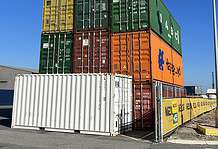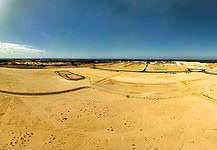An operator stands next to plant machinery on a bauxite plateau at Rio’s Amrun project, Far North QLD. Image: Rio Tinto.
BY CAMERON DRUMMOND
GROWING Chinese demand is driving big investment into the bauxite-rich northwest tip of the Cape York Peninsula, with almost 30mtpa of extra supply due to come online by the end of 2019.
An estimated 53 per cent of Australia’s vast bauxite resources come from the Cape York Peninsula in Far North QLD.
The region’s operating bauxite mines are known for their high quality ore; determined not just by the aluminium content, but also by minerals such as iron oxides and titanium oxides, as well as the low amount of reactive silica which reduces processing costs.
The fundamentals of the bauxite market remain strong, helped in part by China’s crackdown on illegal and environmentally damaging mining practices and declining ore grades at many Chinese mines.
These factors have led to increased Chinese bauxite imports in recent months – a record 7 million tonnes (mt) for December last year – and the opening of new provincial markets in the country.
It’s projected that China’s annual bauxite import requirements will rise from 40mtpa in 2014 to between 65 million tonnes per annum (mtpa) and 75mtpa by 2020.
This has spurred expansion and development of bauxite operations in Australia, with projects on the western Cape York Peninsula leading the charge.
Currently, Rio Tinto is the only producer in the region with two mining operations (South Embley and East Weipa), and a third, Amrun, coming online by the end of 2019.
Other projects are in the late development phase, including Metallica Minerals’ Urquhart, Metro Mining’s Bauxite Hills, and Glencore’s Aurukun.

Amrun has created thousands of construction jobs in the region. Image: Rio Tinto.
Amrun
Rio approved the $US1.9 billion Amrun expansion on the Cape York Peninsula in 2015.
Initial output of 22.8mtpa will replace production from the depleting East Weipa mine and increasing total bauxite production by 10mtpa, with an option to further expand up to a run rate of 50mtpa.
Production and shipping from Amrun is expected to commence in the first half of 2019, ramping up to full production by the end of that year.
The construction workforce would be 1400 people at its peak, with about 80 per cent sourced from QLD.
So far, Rio has awarded more than $1.37bn worth of contracts to QLD suppliers, making up more than two thirds of the $1.93bn in contracts awarded to Australian suppliers for the project to date.
More than 704 QLD businesses have been engaged directly and indirectly to supply goods and services to the site, and a total of $218m of the commitments can also be attributed to the Western Cape York, where 70 companies have been awarded aspects of the overall project.
“From the very beginning of the Amrun project in 2015 we have been committed to prioritising Australian, and in particular QLD companies for goods, services and expertise,” Rio Amrun project director Marcia Hanrahan said.
“It is important to us that the benefits of our investment are returned to home soil and that we play an active role in developing sustainable Australian communities for the future.”
QLD Premier Annastacia Palaszczuk said the significant investment in local and regional suppliers provide a tremendous boost to the State’s economy.
“The Amrun project will ensure QLD businesses and their employees will continue to reap the benefits of many development opportunities for years to come,” Ms Palaszczuk said.
“It is a best practice example of encouraging local and Indigenous participation with substantial employment targets already agreed with many key suppliers.”
Bauxite Hills
Metro Mining’s $36m Bauxite Hills project contains 92.2mt of bauxite reserves for an initial 17-year mine life. Projected underlying earnings out of the mine will be an estimated $2.5 billion.
Production is on schedule to commence in April at a run rate of 2mtpa, with a planned $36.7m expansion to increase throughput to 6mtpa by 2021.
Metro also has environmental approvals in place for an expansion of up to 10mtpa, leaving it well-positioned to ramp up production in response to market demand.
In December last year, Metro signed a Memorandum of Understanding (MoU) with Chinese state-owned enterprise SPIC Aluminium and Electric Power Investment Co (SPIC) for the supply of 6.5mt of bauxite over four years.
This added to previous agreements with Chinese end users to cover 100 per cent of planned 2018 and 2019 production, and 90 per cent of expanded capacity in 2020 and 2021.
Metro managing director Simon Finnis said the MoU was another important milestone for the Bauxite Hills project.
“Once again this demonstrates the strong appetite for our bauxite in the Chinese refining market, and validates our mining and marketing strategy.”
“Construction at the Bauxite Hills mine is virtually complete, and is on schedule to commence production in April 2018, following the end of the Cape York wet season.”

Urquhart & Glencore
Metallica’s Urquhart bauxite project, 5km southwest of Weipa, is a fully funded 50:50 joint venture with Chinese investor Ozore Resources with a production target of between 5mtpa and 7mtpa of bauxite over an initial three to five years.
In January, Metallica took another step closer to tapping into Urquhart’s three billion tonnes of undeveloped bauxite with the granting of its mining lease.
QLD Natural Resources and Mines minister Dr Anthony Lynham said the lease would allow the project to progress into operations later this year.
“The granting of this mining lease will support up to 26 jobs and allow the new mine to produce bauxite for export until 2033,” Dr Lynham said.
The company is awaiting final approval of its haul access road, after which the mine would be up and running in between four and six weeks.
As yet exploration and expansion plans for the project are on hold until Urquhart’s initial ramp up to production.
“The Urquhart bauxite project adds to the project pipeline and follows the recent granting of the mineral development license to Glencore for 283-million tonne Aurukun bauxite project,” Dr Lynham said.
The nearby Aurukun project is also starting to gear up, with QLD Government approval given to Swiss-based miner Glencore.
In late 2017, Glencore was granted a mineral development licence or “MDL” over the Aurukun resource, which allows feasibility studies to commence.
Now the MDL has been granted, Glencore would assess the feasibility of developing the Coconut deposit through a bauxite mine that could produce up to 6mpta over a 20 year mine life.
Aurukun bauxite project director Julian Farrugia said the granting of the licence meant that Glencore could now build on its significant community engagement work.
“Since we first began regularly visiting Aurukun four years ago, we have engaged openly and transparently with the local community and traditional owners, the Wik and Wik Way People,” Mr Farrugia said.
“We have been very pleased with the welcome and support that we’ve received during this time. “With the permission and assistance of the traditional owners, we’ve completed a number of initial on-ground environmental and technical studies during 2017 and we look forward to continuing to work with the community and our key stakeholders throughout the next phase of the project.”






















































